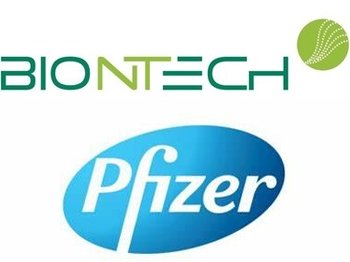
When we last heard from the Pfizer/BioNTech vaccine program, they had picked a different candidate than the one that they had already published on (BNT162b1). Today they’ve released more data about the actual candidate, BNT162b2. And it seems pretty clear why they went with it.
This preprint describes a head-to-head study (NCT04368728) between their two candidates, in a rather wide-ranging trial with 13 different treatment groups varying by the age of the volunteers (18-55 or 65-85) and the vaccine dose (10, 20, or 30 micrograms, each in two doses 21 days apart, with one group getting a single 100 microgram shot). Each group had 12 people dosed with a vaccine candidate and 3 placebo controls.
Overall, the “b2” vaccine produced fewer reactions on injection, and milder systemic reactions such as fever, body ache, etc. Older patients tended to have less reaction than younger ones, with both candidates. This is something to keep in mind – the other day, I was wondering if the mild reactions to the SinoPharm inactivated virus vaccine might indicate that it was raising less of a response, but that is clearly not always the case (I’ve updated that earlier post with a link to this one as well).
The antibody response in the two vaccines was quite similar, and they both showed the same trends (for example, lower neutralizing antibody response in the older patients, one-third to one-half, which will be something watch for when we get efficacy data). The booster shot was definitely needed – antibody titers were far better after the second injection. And while the 20 microgram dose was definitely better than the 10, the 30 microgram dose was slightly better in some groups but not in others. The Phase III, though, will be two doses of the 30 microgram, since it also had no worse safety signals.
The difference between the two candidates is that the b1 vaccine encodes the RBD of the Spike domain, presented as a trimer, while the b2 is the full-length Spike with a few mutations to make it more stable. The b1 therefore has more actual RNA molecules in it than the b2, but the lipid nanoparticle formulation is the same. The paper notes that it’s not clear why the b2 candidate has significantly fewer side effects – the number of RNAs could be part of it, but these effects are also known to depend on the particular RNA sequences involved, so who knows? The authors also mention that they expect a wider variety of T-cell responses from the full-length antigen in the b2 vaccine, but that this study did not include T-cell characterization. Pfizer’s own comments lead one to believe that this is what they’re seeing, but was that based on data or on expectations? At any rate, they say that this will be reported separately, and I look forward to seeing it.
But what I look forward to the most is seeing how all of these Phase I profiles translate to the real world of protection from the damned coronavirus. We’re going to learn more about immunological correlates more quickly than we have ever learned for any pathogen before. There are so many different platforms in trials now, each with their differences, and we will be getting piles of data in rapid succession from trials of tens of thousands of people all over the world. No one would have ever set up such a gigantic experimental landscape under non-emergency conditions; from the clinical perspective it’s an unprecedented immunological Woodstock.
And we’re going to have to get prepared for it. There are several believable outcomes (good, bad, and just plain mixed) that I don’t think that the general public has anticipated, and those will be the subject of a coming post!
